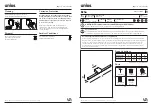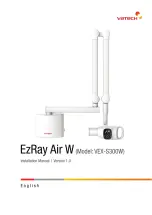
Data Logging
AutoProgram Descriptions
9-22
Using the LI-6400
9
which allows you to enter a CO
2
differential threshold that will cause match-
ing to occur if the absolute value of the sample - reference IRGA is smaller.
If you wanted to match automatically on every observation, enter a large
number (100, 1000, etc.). If you never want to match automatically during the
AutoProgram, enter 0. Typically, you might want to use 15 or 20 µmol mol
-1
as the threshold.
If matching occurs (for either software version), it occurs immediately after
the minimum wait time. Following automatic matching (which typically
takes about 30 seconds), there will be a short delay (10 seconds), then the
maximum wait time and stability checking is entered. Thus, automatic match-
ing tends to increase the total time between logging events by about 40 sec-
onds.
Two Styles for ÒProgramÓ
The
Program
field (Figure 9-16 on page 9-20) has two styles with the
A-Ci-
Curve
AutoProgram (and also
LightCurve
). The delimiter used is a semico-
lon, or asterisk, as explained in Table 9-4.
ÒAutoLogÓ
AutoLog
is designed to log instantaneous data at regular intervals. (If you
need data faster than every 2 or 3 seconds, then you should use
Buffered AutoLog
instead).
■
■
■
■
AutoLog prompts for the following:
1
Log every __ secs:
Enter the desired period between logged observations.
2
Add __ observations:
This determines how many observations
AutoLog
should record. If you man-
ually log data while AutoLog is running, it does
not
affect when
AutoLog
quits.
Table 9-4.
Delimiters used in the Program field for
A-CiCurve
and
LightCurve
.
Style
Meaning
00;01;30
(In minimum wait time) 1 minute 30 seconds remains until
the program starts checking for stability to see if it can log
data.
00*01*30
(Checking stability) As soon as the stability meets the cri-
terion, it will log. Otherwise, logging will occur in 1
minute and 30 seconds.
Summary of Contents for LI-6400
Page 1: ...Using the LI 6400 Portable Photosynthesis System ...
Page 15: ...Part I The Basics ...
Page 16: ......
Page 174: ...Making Measurements Answers to Questions 4 56 Using the LI 6400 4 ...
Page 175: ...Part II Useful Details ...
Page 176: ......
Page 200: ...Standard Tools Power ON Hooks 5 24 Using the LI 6400 5 ...
Page 214: ...Real Time Data Real Time Graphics 6 14 Using the LI 6400 6 ...
Page 234: ...Environmental Control Light Control 7 20 Using the LI 6400 7 ...
Page 244: ...Light Sensor Considerations Gallium Arsenide Phosphide GaAsP Sensor 8 10 Using the LI 6400 8 ...
Page 288: ...Data Logging Making Your Own AutoPrograms 9 44 Using the LI 6400 9 ...
Page 289: ...Part III Working With Files ...
Page 290: ......
Page 312: ...The LPL File System Troubleshooting 10 22 Using the LI 6400 10 ...
Page 340: ...Downloading Files Using a Data Capture Program 11 28 Using the LI 6400 11 ...
Page 375: ...Part IV Configuration Issues ...
Page 376: ......
Page 420: ...Defining User Variables Old Style vs New Style 15 18 Using the LI 6400 15 ...
Page 454: ...Using an Energy Balance Further Reading 17 12 Using the LI 6400 17 ...
Page 455: ...Part V Maintenance Troubleshooting ...
Page 456: ......
Page 572: ...Troubleshooting Useful Information 20 46 Using the LI 6400 20 ...
Page 593: ...Part VI Programming ...
Page 594: ......
Page 622: ...Programming with LPL Compiler Directives 22 28 Using the LI 6400 22 ...
Page 846: ...Index I 16 Using the LI 6400 ...
















































